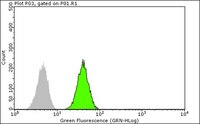05-1592 Sigma-AldrichAnti-mTOR Antibody, clone 21D8.2
Anti-mTOR Antibody, clone 21D8.2 is an antibody against mTOR for use in WB & IC.
More>> Anti-mTOR Antibody, clone 21D8.2 is an antibody against mTOR for use in WB & IC. Less<<Prodotti consigliati
Panoramica
| Replacement Information |
|---|
Tabella delle specifiche principali
| Species Reactivity | Key Applications | Host | Format | Antibody Type |
|---|---|---|---|---|
| H, M | WB, ICC | M | Purified | Monoclonal Antibody |
| References |
|---|
| Product Information | |
|---|---|
| Format | Purified |
| Control |
|
| Presentation | Purified immunoglobulin containing 0.1 M Tris-Glycine, pH 7.4, 150 mM NaCl and 0.05% Sodium Azide. |
| Quality Level | MQ100 |
| Physicochemical Information |
|---|
| Dimensions |
|---|
| Materials Information |
|---|
| Toxicological Information |
|---|
| Safety Information according to GHS |
|---|
| Safety Information |
|---|
| Storage and Shipping Information | |
|---|---|
| Storage Conditions | Maintain refrigerated at 2-8°C for 1 year from date of receipt. |
| Packaging Information | |
|---|---|
| Material Size | 100 µg |
| Transport Information |
|---|
| Supplemental Information |
|---|
| Specifications |
|---|
| Global Trade Item Number | |
|---|---|
| Numero di catalogo | GTIN |
| 05-1592 | 04053252586217 |
Documentation
Anti-mTOR Antibody, clone 21D8.2 MSDS
| Titolo |
|---|
Anti-mTOR Antibody, clone 21D8.2 Certificati d'Analisi
| Titolo | Numero di lotto |
|---|---|
| Anti-mTOR, clone 21D8.2 - 3182611 | 3182611 |
| Anti-mTOR, clone 21D8.2 - 3204352 | 3204352 |
| Anti-mTOR, clone 21D8.2 - 3379935 | 3379935 |
| Anti-mTOR, clone 21D8.2 - 3597290 | 3597290 |
| Anti-mTOR, clone 21D8.2 - 3854590 | 3854590 |
| Anti-mTOR, clone 21D8.2 - 3904347 | 3904347 |
| Anti-mTOR, clone 21D8.2 - 4199614 | 4199614 |
| Anti-mTOR, clone 2ID8.2 - 2119002 | 2119002 |
| Anti-mTOR, clone 2ID8.2 - 2462850 | 2462850 |
| Anti-mTOR, clone 2ID8.2 - 2031348 | 2031348 |










